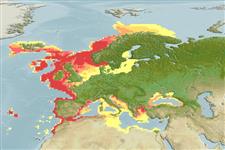Environment: milieu / climate zone / depth range / distribution range
Écologie
marin bathydémersal; profondeur 20 - 1000 m (Ref. 6302). Deep-water; 75°N - 30°N, 28°W - 46°E (Ref. 54568)
Eastern Atlantic: south-western Barents Sea to Strait of Gibraltar including the Mediterranean and Black Sea. Reported from Iceland (Ref. 4712) and Mauritania (Ref. 5377). North Atlantic specimens attain larger sizes than those collected off West Africa and they also occur in shallower depths.
Length at first maturity / Taille / Poids / Âge
Maturity: Lm 55.0, range 35 - 60 cm
Max length : 200 cm SL mâle / non sexé; (Ref. 4712); common length : 100.0 cm SL mâle / non sexé; (Ref. 4712); poids max. publié: 57.7 kg (Ref. 40637); âge max. reporté: 24 années (Ref. 46508)
Description synthétique
Morphologie | Morphométrie
Épines dorsales (Total): 8; Rayons mous dorsaux (Total): 11-12; Rayons mous anaux: 9 - 10. Peritoneum pale. Head and body depressed. Mouth wide and cavernous. Skin thin and loose, scales absent. Esca bifid, 2 broad, flattened , leaf-like blades. Dorsal spines long, stout and bearing many well-developed tendrils; 4th spine greater than snout width (Ref. 4712).
Occurs on sandy and muddy bottoms from the coast (below 20 m, Ref. 12382) down to depths of 1,000 m. May also be found on rocky bottoms (Ref. 12382). It lies half-buried in the sediment waiting for its prey. It attracts prey by means of its fishing filament (Ref. 5377). Feeds mainly on fishes, occasionally sea-birds. Marketed fresh and frozen; eaten steamed, sautéed, broiled, boiled, fried, microwaved and baked (Ref. 9988). It is a well-studied species in Europe and is sold without the skin and the head under the name 'queue de Lotte' (Ref. 5377). Does not adapt well in home aquariums due to its large size (Ref. 12382).
Caruso, J.H., 1986. Lophiidae. p. 1362-1363. In P.J.P. Whitehead, M.-L. Bauchot, J.-C. Hureau, J. Nielsen and E. Tortonese (eds.) Fishes of the North-eastern Atlantic and the Mediterranean, Volume 3. Unesco, Paris. (Ref. 4712)
Statut dans la liste rouge de l'IUCN (Ref. 130435)
Menace pour l'homme
Harmless
Utilisations par l'homme
Pêcheries: hautement commercial
Outils
Articles particuliers
Télécharger en XML
Sources Internet
Estimates based on models
Preferred temperature (Ref.
123201): 3.8 - 14.2, mean 7.7 °C (based on 468 cells).
Phylogenetic diversity index (Ref.
82804): PD
50 = 0.5078 [Uniqueness, from 0.5 = low to 2.0 = high].
Bayesian length-weight: a=0.01698 (0.01352 - 0.02134), b=2.91 (2.84 - 2.98), in cm total length, based on LWR estimates for this species (Ref.
93245).
Niveau trophique (Ref.
69278): 4.5 ±0.1 se; based on diet studies.
Generation time: 11.0 (8.5 - 14.1) years. Estimated as median ln(3)/K based on 13
growth studies.
Résilience (Ref.
120179): Milieu, temps minimum de doublement de population : 1,4 à 4,4 années (K=0.07-0.33; tm=4.5-14; tmax=24; Fec=1 million).
Prior r = 0.48, 95% CL = 0.32 - 0.72, Based on 7 stock assessments.
Fishing Vulnerability (Ref.
59153): High vulnerability (64 of 100).
Climate Vulnerability (Ref.
125649): Moderate vulnerability (44 of 100).
Nutrients (Ref.
124155): Calcium = 10.8 [5.5, 23.4] mg/100g; Iron = 0.381 [0.157, 0.847] mg/100g; Protein = 19.9 [16.2, 22.3] %; Omega3 = 0.214 [0.097, 0.481] g/100g; Selenium = 19.7 [7.1, 58.6] μg/100g; VitaminA = 4.58 [0.76, 28.24] μg/100g; Zinc = 0.137 [0.073, 0.438] mg/100g (wet weight); based on
nutrient studies.
